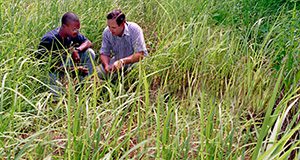Cogongrass (Imperata cylindrica (L.) Beauv.) is a Southeast Asian warm-season perennial grass species that has spread to all continents except Antarctica. It is considered among the worst problematic weeds on a global scale. Control of cogongrass is difficult, especially in forests. This 6-page fact sheet written by Patrick J. Minogue, Brent V. Brodbeck, and James H. Miller and published by the UF/IFAS School of Forest Resources and Conservation presents recommendations for control strategies that will work in mixed pine-hardwood forests and pine forests.
http://edis.ifas.ufl.edu/fr411
Tag: Forest Vegetation Management
Biology, Control and Invasive Potential of Giant Reed (Arundo donax L.) in Florida

Arundo donax (L.), also known as giant reed, is a tall, fast-growing, bamboo-like grass that under ideal conditions can reach a height of up to 30 feet and a stem diameter up to 1.5 inches. Giant reed is invasive and difficult to control and has caused economic losses in California, Nevada, Utah, Arizona, New Mexico, and Texas. This species was introduced to Florida over 100 years ago and is currently naturalized in at least 26 of the 67 Florida counties. So far giant reed has not proved problematic in Florida, but recent permitting of its planting for bioenergy feed stock may increase the risk that it could naturalize into plant communities in Florida and other southeastern states and potentially cause economic losses as well as harm to native species and habitats. This 5-page fact sheet written by Pat Minogue and Seth Wright and published by the School of Forest Resources and Conservation describes the biology of this species and explains some strategies for its control.
edis.ifas.ufl.edu/fr396
Forest Herbicide Characteristics (FOR283/FR345)
 The effectiveness and safe use of herbicides registered for forest vegetation management in Florida requires developing site-specific herbicide prescriptions made with careful consideration of site factors and knowledge of the chemical and physical properties of herbicides and their effects on biological systems. This 9-page fact sheet was written by Anna Osiecka and Patrick J. Minogue, and published by the UF Department of School of Forest Resources and Conservation, May 2011.
The effectiveness and safe use of herbicides registered for forest vegetation management in Florida requires developing site-specific herbicide prescriptions made with careful consideration of site factors and knowledge of the chemical and physical properties of herbicides and their effects on biological systems. This 9-page fact sheet was written by Anna Osiecka and Patrick J. Minogue, and published by the UF Department of School of Forest Resources and Conservation, May 2011.
http://edis.ifas.ufl.edu/fr345
Considerations for Developing Effective Herbicide Prescriptions for Forest Vegetation Management (FOR273/FR335)
Developing a herbicide treatment prescription is a complex process that involves matching a suitable herbicide program with a specific silvicultural operation and an overall management objective. This 8-page fact sheet reviews important considerations in developing effective and environmentally sound herbicide recommendations for managing vegetation in forests. It is intended for use by private forest land owners, foresters, and other land managers. Written by Anna Osiecka and Patrick J. Minogue and published by the UF Department of School of Forest Resources and Conservation, May 2011.
http://edis.ifas.ufl.edu/fr335
Saw Palmetto Control: Individual Plant and Broadcast Application (SSAGR341/AG351)
Saw palmetto is a shrubby palm species native to Florida and common throughout the state. Despite its beneficial uses, saw palmetto is a serious weed problem in pastures, forests, and non-cropland areas, and control of this common native plant is often necessary. This 4-page fact sheet provides mechanical and chemical control recommendations. Written by Brandon Fast, Jason Ferrell, and Brent Sellers, and published by the UF Department of Agronomy, March 2011.
http://edis.ifas.ufl.edu/ag351
CIR1475/FR158 Herbicides Registered for Pine Management in Florida – 2008
Revised! Circular 1475, a 14-page fact sheet by Anna Osiecka, Patrick Minogue, Alan Long, Jarek Nowak, and Mark Mossler, provides comprehensive information about the herbicides currently registered for use in Florida pine plantations. Published by the UF School of Forest Resources and Conservation, February 2009.
http://edis.ifas.ufl.edu/FR158
FOR180/FR245 Mechanical Vegetative Management
FOR180, an 8-page illustrated fact sheet by Rien M. Visser, Bruce Hull, Sarah F. Ashton, and Martha C. Monroe, discusses the mechanical means to manage vegetation in interface forests and reviews available technologies that may be most useful in small, visible, and sensitive forests that are typical of the interface. Includes references. Published by the UF School of Forest Resources and Conservation, October 2008.
http://edis.ifas.ufl.edu/FR245
FOR191/FR252 Biology and Management of Cogongrass
FOR-191, a 3-page illustrated fact sheet by Rick Williams and Patrick J. Minogue, describes the biology and management strategies for this noxious weed native to warm regions of southeast Asia that can cause loss of productive forest areas, hinder forest activities and severely degrade wildlife habitat by replacing native plants. Includes references. Published by the UF School of Forest Resources and Conservation, May 2008.
http://edis.ifas.ufl.edu/FR252
FOR189/FR250 Biology and Management of Chinese Privet
FOR-189, a 3-page illustrated fact sheet by Rick Williams and Patrick Minogue, describes this semi-evergreen to evergreen thick-forming shrub which was introduced as an ornamental shrub in the South in 1852 and is widely naturalized in the Panhandle and northern counties — its biology and management strategies. Includes references. Published by the UF School of Forest Resources and Conservation, July 2008.
http://edis.ifas.ufl.edu/FR250
FOR190/FR251 Biology and Management of Chinese Tallow Tree
FOR-190, a 3-page illustrated fact sheet by Rick Williams and Patrick Minogue, describes this noxious weed introduced originally for oil production and favored as an ornamental, its biology and management strategies.
http://edis.ifas.ufl.edu/FR251
